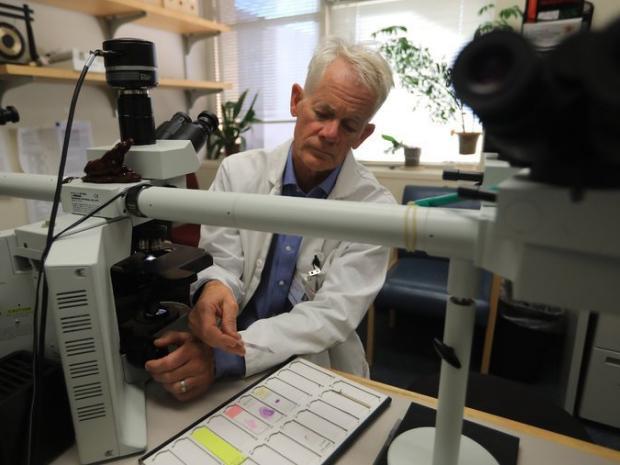Stephen Paddock: Las Vegas shooter’s brain to be examined in bid to understand motive behind massacre
Neuropathologists at Stanford University Medical Center to assess gunman's cerebrum

The brains typically come by Federal Express. They arrive a couple of times a month at the laboratory of Dr Hannes Vogel, director of neuropathology at Stanford University Medical Center. He prefers to receive them whole, fixed in formalin, along with their coverings and spinal cords.
One of the next brains to arrive, expected early next week, will be that of Stephen Paddock, who killed 58 concertgoers in Las Vegas earlier this month in a rampage without any clear motive. While law enforcement officials attempt to understand the mass shooting by gathering evidence and interviewing those who crossed the gunman’s path, Vogel is preparing to look for clues in the remains of Paddock’s brain. In a series of interviews, the first he has given on the case, he spoke about the work he plans to do.
Earlier, the office of the Clark County coroner had announced that an autopsy on Paddock had been completed and that tissues from his skull would be sent to Stanford to search for a potential brain disorder.
“Don’t spare any expense,” Vogel said he was told by a pathologist in the coroner’s office.
“The magnitude of this tragedy has so many people wondering how it could have evolved,” Vogel said.
That includes whether any one of more than a half-dozen neurological diseases proposed to the coroner’s office might have played a role. Even though the chances of finding answers in the brain tissue to the mystery of Paddock’s act are slim, Vogel said, “all these speculations out there will be put to rest, I think.”
Examinations of the brains of individual mass killers have been performed in the past, but experts said they were not aware of any compilation of the findings.
Vogel, one of the relatively few academic neuropathologists to focus on forensics, said he planned to look for and photograph any gross abnormalities, such as a tumuor or malformation, that could be felt or seen by the eye alone.
Then he will focus on interior structures. Paddock’s brain has already undergone an initial assessment, but Vogel will probably dissect it further, cutting vertically from the top with a large knife oriented as if from ear to ear. He will take samples of the tissue, and colleagues will create paper-thin slices, mount them onto slides and treat them with stains that highlight potential abnormalities of individual cells.
Vogel said he was briefed Wednesday about the condition of the shooter’s brain, including damage caused by an apparently self-inflicted bullet wound to his head. While the injury may compromise the overall assessment of the brain, he said, “I think for a lot of things people are speculating about, it’s still quite usable, pending viewing it.”
Still, he and five other experts in his field sought to dampen public expectations.
“It’s a tricky, tricky business,” said Dr Jan E. Leestma, the author of the textbook Forensic Neuropathology and a consultant who, a decade ago, offered testimony opposing that of Vogel in a murder case. “The correlation of what might be structurally there to behaviour is very difficult. Often it raises more questions than it answers.”
In the case of the Las Vegas gunman, who was 64, there has been speculation focused on a disease process known as fronto-temporal lobar degeneration. It affects areas of the brain that are vital for “executive functions” like decision-making and social interaction. The disease often strikes in a patient’s 50s or 60s and can cause marked personality changes; it is sometimes hereditary.
“These people are notoriously prone to errors in judgement and unrestrained behaviour,” Vogel said. But in Paddock’s case, “people will say in the same breath that this guy was so meticulous in planning and so forth, that that would seem unlikely.”
Still, he said that in his examination of the brain, “that would probably be the area I wouldn’t want to leave any stone unturned.”
Stanford typically has a weekly session where brains are cut and studied in a side room of the hospital morgue, with a group in attendance that includes senior doctors and trainees. But Vogel said he would probably analyse Paddock’s brain alone, because of the high profile of the case. The results will be sent directly to the coroner’s office, he said, and all the materials returned.
Las Vegas shooting – in pictures
Show all 15Vogel said the price of a basic brain examination, including microscopic views of eight to ten sections, runs about $500, including both the hospital’s and the doctor’s fees. Using special stains on the tissue can increase the price.
He said he would look for signs of all the standard detectable neurological entities, including strokes, blood vessel diseases, tumours, certain types of epilepsy, multiple sclerosis, degenerative disorders, physical trauma and infections. Most psychiatric illnesses, however, are not currently discernible by this type of examination.
“I think everybody is pretty doubtful that we’re going to come up with something,” Vogel said. “The possibilities, neuropathologically, for explaining this kind of behaviour are very few.”
The New York Times
Subscribe to Independent Premium to bookmark this article
Want to bookmark your favourite articles and stories to read or reference later? Start your Independent Premium subscription today.

Join our commenting forum
Join thought-provoking conversations, follow other Independent readers and see their replies